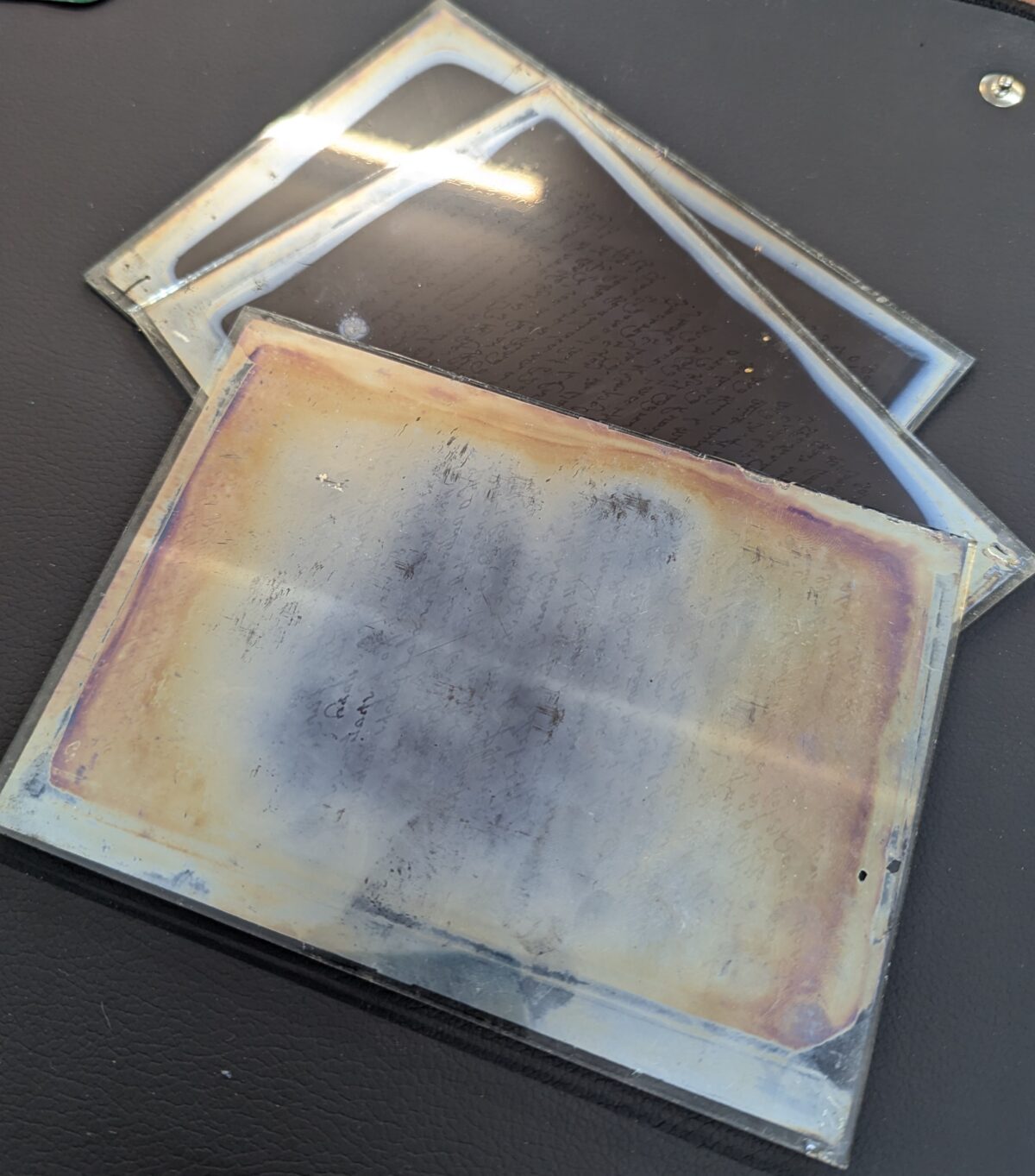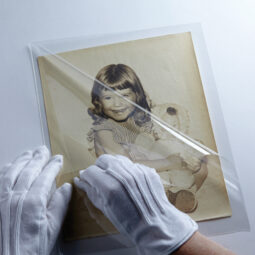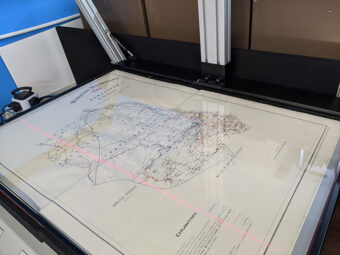Blog Overview and History of Glass Plate Negatives
This blog begins with a brief overview of the history of glass plate negatives beginning with their invention in the mid-nineteenth century and their usage through the first quarter of the twentieth century.
The paper then explores the storage of glass plate negatives including current research on their ideal physical environment, shelving and the use of enclosures and sink mats.
The blog then discusses handling techniques (including retrieval) as well as common conservation concerns including the chemical breakdown of the glass, appropriate ways to deal with broken and cracked glass and the problem of image separation from the glass. The paper concludes with a discussion of the reformatting of glass plate negatives and the use of scanning and digitization as a means to create preservation and user copies.
A Brief History of the Two Photographic Processes
The first photography processes were developed during the first half of the nineteenth century. Between the years 1826 and 1839 three separate individuals – Joseph Nicéphore Niepce, Louis Jacque Mandé Daguerre and William Henry Fox – independently developed the earliest photographic techniques (Vail, 2002, p. 1-2). In 1851 the British inventor Frederick Scott Archer expanded on the discoveries of these early photography pioneers and produced the first wet plate glass plate negative.
The advent of the glass plate negative resulted in an increased interest in photography. Do-it-yourself manuals cropped up during the 1860s and assisted both the amateur and professional photography in the creation of glass plate photographs. In 1864 John Towler published The Silver Sunbeam and, in it he outlined the new photographic process in just ten easy steps (!). Towler stated that “the operation of taking a collodion positive on glass consists of the following subdivisions” (Towler, 1864, n.p.):
-
Preparing the glass plate.
-
Coating the prepared plate with collodion.
-
Sensitizing the plate.
-
Exposing the prepared plate in the camera.
-
Developing the picture.
-
Fixing the image.
-
Drying the plate.
-
Remove any particles which may be settled on the plate.
-
Flow the plate with the “purest and most transparent crystal varnish, precisely in the same manner as the plate was covered with collodion” (Towler, 1864, n.p.).
-
Apply a dark background to the plate in the form of black velvet or paper.
Towler’s publication (and the many others like it) helped foster the growing interest in glass plate photography. This interest eventually spread to all reaches of the earth and to almost every walk of life. From Queen Victoria to Matthew Brady, glass plate photography captured intimate views of royalty, scenes of war and destruction and pastoral views of everyday life.
Frederick Scott Archer’s wet plate negative was produced by spreading a glass plate with collodion, a flammable liquid made of cellulose nitrate and ether. The glass plate was then placed into a bath of silver nitrate which turned the collodion into a photosensitive silver iodide (Vail, 2002, p. 1). The wet plate was then exposed in a camera. The photographer then had approximately five minutes to complete the exposure before the wet plate dried. The exposed plate was then protected with a coat of varnish (Hendricks, 1992, pp. 48-49). The wet plate negative was in use from the early 1850s until the late 1880s, before being almost completely replaced by the more convenient dry plate negative process.
In 1871, Richard Leach Maddox developed the first practical dry plate negative process. Maddox’s technique involved fixing a light-sensitive gelatin emulsion to a glass plate. The plate was then allowed to dry before it was exposed in the camera. The dry plate process featured many of the same steps as the wet plate process but utilized different sensitizing, fixing and development solutions. The dry plate photographic technique was used from the 1870s until the first quarter of the twentieth century, when it was then surpassed in both ease and popularity by the gelatin silver paper negative and the gelatin silver negative on celluloid roll film (Vail, 2002, p. 1). The dry plate negative process is still used occasionally for highly specialized photography, such as the creation of exact astronomical measurements (Keefe and Inch, 1984, p. 252).
While the two separate glass plate negative photographic methods are chemically different from each other, they have very similar storage, care and handling needs. The proper storage of glass plate negatives begins with establishing acceptable temperature and relative humidity levels. Cooler temperatures will slow the rate of chemical reactions that cause degradation, but caution should be taken to avoid too low of a temperature which can render the glass, photographic emulsion and binders brittle (Herskovitz, 1999, p. 5). The ideal storage environment for glass plate negatives is “less than 65º Fahrenheit with minimal fluctuation (+/- 2 degrees), and an ideal relative humidity is 30% RH with minimal fluctuation (+/-3 percent)” (Herskovitz, 1999, p. 5).
After establishing standard temperature and relative humidity levels, negatives should be re-housed in a preservation friendly environment. This can involve removing the negatives from their original wooden studio crates or other suboptimal storage method. Following any uncrating or unboxing, each negative should be re-housed in an individual paper enclosure or sink mat. Selections should also be made regarding appropriate load-bearing boxes and heavy-load capacity shelving (U.S. National Archives and Records Administration, “How Do I House Glass Plate Negatives?” 2001, p. 1).
Individual plates should be placed in loosely-fitting buffered paper sleeves or four flap envelopes. If seamed envelopes are selected for the storage of plates, side-seamed envelopes should be used in order to prevent the envelope’s adhesives from interacting with the photographic emulsion. Four flap paper envelopes are the ideal storage envelope, as they do not use adhesives and eliminate the risk of a negative chemical interaction between the adhesives and the emulsion. Four flap envelopes are advantageous for other reasons. The flap enclosure also “allows for the examination and even printing [of the plate] without sliding the negative in and out of a sleeve” ( Wilson , 1999, p. 5).
After individually enclosing each negative in an envelope, glass plate negatives should be stored vertically along their longest edge and placed into appropriately sized document boxes. Negatives should be stored with other plates of the same size in order to prevent edge pressure on any odd sized negatives. A small negative can be crushed or moved side-to-side if stored in a box with a group of larger negatives. A large negative in a box with smaller negatives is equally vulnerable. The edges of the larger negative will not receive physical support from its neighbors, and it will be more prone to cracking and breakage (Herskovitz, 1999, p. 4). Glass plates should be placed neatly and carefully within the boxes in order to minimize any side-to-side movement and abrasion of the plates. Each box should be interleaved with acid-free corrugated board spacers in order to minimize shifting within the box. These spacers should be cut to the size of the plates in order to fully support the plates and placed at one inch intervals within the box.
Glass plate negatives are generally stored in sturdy P.A.T.-tested document boxes. It is critical that these boxes be of an appropriate size and constructed of a heavy board to support the weight of the glass. Many commercial archival supply companies such as University Products and Gaylord sell document boxes specifically weighted for glass plate negatives. Many archivists believe it is better to use a larger quantity of smaller boxes than a fewer number of larger sized boxes in order to prevent strain on the boxes and any staff involved in the handling of the negatives. If a box cannot be filled, corrugated cardboard filler pieces should be cut to size and placed in the boxes to snug up plates and fill out any extra space in the container. These filler pieces will keep plates upright and prevent any front-to-back movement within the box.
Within the storage facility, the boxes should be placed on shelving units capable of housing glass plate negatives. There are several factors to consider when selecting appropriate shelving units for glass plates. These factors include: the shelving unit’s “load rating,” the type of materials used in the construction of the unit and the shelving unit’s finish (Herskovitz, 1999, pp. 4-5). To judge the necessary load rating for a shelving unit, staff should calculate the number of negatives to be housed, the size of document boxes to be used and the number of boxes able to fit on a shelf. The overall footprint of the storage facility is another important factor to consider when purchasing shelving units. Perhaps two smaller units make more sense than one larger unit when factors such as cart mobility and ease of retrieval are considered.
Shelving units should be made from steel rather than wood. Many of the glues and adhesives used to manufacture plywood have a tendency to off-gas volatile organic compounds such as formaldehyde and acetic acid. Both of these chemicals can be damaging to photographic collections, and their introduction to collection storage should be avoided. Additionally, wood shelving may not meet the necessary load rating. Finally, the shelving unit’s finish is also of concern. Powder coated finishes that use no solvents are highly desirable, but several solvent-based finishes that create a film-forming resin of 100% polyester or acrylic are also acceptable as are two-component epoxy shelving (Herskovitz, 1999, p. 5).
Boxes of glass plate negatives should not be stacked, but rather the shelf’s height should be adjusted to match the height of the boxes. Boxes should also be placed at an accessible height with care taken to avoid locations that are too high or low. This precaution is to prevent any physical strain on staff involved in the retrieval of archival materials. Reaching for a heavy, awkward box from a stretching or stooping position can be dangerous to both the plates and the staff member involved. A final step in the creation of proper storage is the labeling of all boxes and shelving units. Each box should be clearly marked with the phrase: “CAUTION. FRAGILE GLASS NEGATIVES. HEAVY.”
The storage of broken plates and those with flaking emulsions present added challenges, and additional steps are needed to ensure their protection. Broken plates should be housed in specially constructed protective sink mat enclosures made from corrugated board. The individual plate fragments should be aligned to their proper location within the photograph and small spacers placed between the fragments to prevent further chipping or breaking. The spacers, generally small squares, rectangles or punched circles, are usually constructed of acid-free corrugated board or acid-free mat board (U.S. National Archives and Records Administration, “How Do I House Glass Plate Negatives?” p. 2). Sink-matted plates can be stacked up to five high inside a shallow print storage box or map storage case.
In addition to problems with broken and cracked glass, it is not unusual for glass plates to exhibit problems with flaking emulsion. Plates that exhibit problems with minor flaking, such as a few small edge losses or losses near chips, should be housed in the standard four-flap envelope. The envelope should be labeled on the exterior: “CAUTION: FLAKING EDGES. HANDLE WITH CARE” (U.S. National Archives and Records Administration, “How Do I House Glass Plate Negatives?” p. 2). Glass plates with significant flaking that includes hanging flaps or tears of emulsion and/or overall cracking of the emulsion should be treated more aggressively. Preservation copies of the images should be created in order to minimize the need to handle the originals and, the flaking plate should then be placed in a sink mat enclosure and stored flat (Herskovitz, 1999, pp. 3-4). The sink mat enclosure should then be labeled: “FLAKING GLASS PLATE. HANDLE WITH EXTREME CAUTION. USE DUPLICATE COPY.”
Handling Techniques for Glass Plate Negatives
The handling of glass plate negatives should be done with extreme care. Glass plates are most vulnerable to cracking and breaking during the periods in which they are handled. Proper handling techniques begin with a properly prepared work surface. A work surface should be a clean, flat, dry table that is free of any debris. The work table should be of adequate size to safely accommodate the document box, the individual negative in its enclosure and any other needed equipment (U. S. National Archives and Records Administration, “How Do I House Glass Plate Negatives?” p. 1).
Many archivists recommend the wearing of non-vinyl plastic gloves for the handling glass plates. These types of gloves include both Latex and Nitrile gloves. Cotton gloves are not worn as they are too slippery for handling glass and any loose cotton fibers may pose a risk of snagging any flaking emulsion (U. S. National Archives and Records Administration, “How Do I House Glass Plate Negatives?” p. 1). When working with a plate, always place the emulsion side up. This prevents any debris from scratching the photographic surface.
Common sense dictates that glass negatives should never be subjected to pressure or stacking. The tremendous weight of a stack of glass plates places unnecessary stress on the bottom plates. Staff and users should be instructed not to press, lean or write on a glass plate. If the negative’s enclosure is to be labeled with its accession number, negative number or box identification, it should always be labeled prior to inserting the plate.
The retrieval of glass plates from storage also involves a combination of common sense and staff training. The moving and handling of the plates should be done in the plate’s storage orientation – that is with the plate resting along its longest edge (U. S. National Archives and Records Administration, “How Do I Move Glass Plate Negatives?” p. 1). A cart should always be used for moving boxes of plates. The use of a cart ensures against any unnecessary strain to the document boxes and any staff involved in the transfer of heavy plates. Any cart used for transporting glass plate negatives should be rated for the weight load of glass and possess pneumatic, air-filled tires. Carts with common utility casters made from hard rubber or plastic should be avoided as they fail to absorb vibrations. The cart should also possess a locking break and tip/shock sensors (U. S. National Archives and Records Administration, “How Do I Move Glass Plate Negatives?” p. 1). The proper loading of a cart is as important as purchasing the proper type of cart. The cart’s shelves should be padded out with moving blankets and/or foam cut to the size of each shelf. Boxes should be placed in the center of the cart with all boxes oriented in the same direction. A cart should never be stacked higher than the height of two boxes in order to prevent the tipping a top-heavy load and/or impeding the cart’s ability to turn corners.
The preservation and survival of glass plate negative seems somewhat remarkable given the fragility of the glass itself and the common 19 th century practice of “plate recycling.” Throughout the 19 th century, local junk men would purchase old, unwanted glass plates, scrape off the photographic emulsion and resell the glass to greenhouses and dry-plate manufacturers. The dry plate manufacturers readily purchased this glass, as it could be easily reused and was already cut to standard photographic sizes (Keefe and Inch, 1984, p. 252).
Perhaps one of the most challenging aspects of preserving glass plate negatives is learning to visually distinguish between the two photographic processes. In the words of noted photography conservator Constance McCabe, “Various chemical processes were employed to create these negatives, and deterioration may have taken place over time. The effects of these and unknown factors give the negatives image appearances that may be difficult or impossible to explain. To generalize about the appearance of collodion and gelatin glass plate negatives is not possible, as both have similar characteristics that may make differentiation confusing. It should be noted that unless deterioration is evident, preservation of both negative types requires similar approaches.” Despite using a similar preservation approach for both processes, it is important not to confuse or interchange the two photographic processes when conducting an actual conservation treatment. The conservation of the wet and dry plate processes “differ significantly depending on the nature and extent of deterioration” (Keefe and Inch, 1984, p. 43). A professionally trained conservator who specializes in 19 th century photographic preservation is the best resource for determining the proper course of treatment.
Glass plate negatives present unique preservation challenges due to their fragile physical format and highly varied chemical structures. As with any archival collection, knowledge of the “constituent materials of permanently valuable archival records is important to determining proper long-term preservation measures” (McCabe, 1991, p. 42). This concept translates to a thorough understanding of the manner in which archival materials were constructed, their component materials and the manner and rate in which these materials deteriorate. This understanding of the manufacturing process is complicated by the many variations in chemical formulas used by 19 th century photographers. Every photographer developed his or her own preferred methods and formulas for the collodion, developers, fixers, post-processing treatments and varnishes. In addition, many different types of glass were available to photographers. These variations in methods and materials combined with errors made by the photographer are preservation concerns that are almost impossible to mitigate. Glass plate negatives are also vulnerable to various external agents of deterioration.
These external agents include heat, water damage, extremely high and/or low relative humidity levels, atmospheric pollutants and mold attacks (Keefe and Inch, 1984, pp. 252-253). These agents of degradation contribute to the most common preservation problems regarding glass plate negatives: the deterioration of the glass plate and the chemical stability of the negative’s other components (including the silver image, the collodion and varnish layers).
Prior to the late 1990s, it was not commonly accepted that the glass itself could be a factor in the deterioration of photographic plates. The deterioration of the glass is often moisture-related. By the early 1990s, the National Archives recognized that many of their plates were undergoing a chemical change on the non-image side of the glass plate. This meant that the glass itself was changing in its chemical structure. The non-image sides of the plates can exhibit a crystalline deposit that is often characterized as being either sticky or slippery (McCabe, 1991, p. 42). The image side of the glass also exhibits problems with softening as the glass degrades and can exhibit problems with the lifting of the binder and varnish layers. Additionally, the glass plate itself can become increasingly brittle and more prone to cracking and breaking. These changes in the chemical structure of the glass are closely associated with variations in environmental conditions, especially changes in relative humidity levels. The hygroscopic nature of the salts found in the glass can also contribute to the deterioration of the silver image.
The stability of the glass negative’s other chemical components can also be problematic. The silver image is subject to oxidative deterioration, which often presents itself in the fading and discoloration of the image. The oxidation of the silver image is often initially caused by poor chemical processing and the use of unstable materials, but the condition is exacerbated by elevated relative humidity levels, atmospheric pollutants and low quality storage enclosures. Collodion, the binder in which the image’s silver particles are suspended, can also present preservation concerns. Collodion is composed of cellulose nitrate – a chemical compound that is known to be unstable. Some archivists and conservators have theorized that the collodion negative could be as unstable as cellulose nitrate film support (McCabe, 1991, p. 46). The National Archives concluded that while the cellulose nitrate in the collodion is of concern, it is less a factor in deterioration of negatives than the degradation of the glass support.
The stabilization of glass plate negatives is a multi-step process. These steps begin with condition assessment reports and a survey of the plates storage needs. Stabilization continues with the cleaning of the negative, including the removal of any pressure sensitive tape and/or adhesives. This is generally followed by the reformatting and re-housing of the negatives and concludes with the placement of the original negatives into cold storage (McCabe, 1991, p. 47).
As with many types of archival materials, there is often a conflict between providing public access to glass plate negatives and ensuring their preservation. Some archivists at the National Library of Australia have even argued that this is the key issue surrounding glass plate negatives. “The most important aspect of glass negative preservation is to ensure the image is retained and made accessible” (National Library of Australia, 1996, p. 2). In order to attain both goals of access and preservation, glass plate negatives should be reformatted. Reformatting creates copy negatives for public access and minimizes the need to view originals which can then be placed into cold storage.
Traditionally glass plate negatives were duplicated by creating contact-prints onto Kodak S0-015 paper combined with the use of Direct Duplicating Film. Direct Duplicating Film resulted in negatives of the same size and shape as the original (Keefe and Inch, 1984, pp. 252-253). Today new standards in digital technology have been developed that make the reformatting process easier, faster and more readily available to smaller institutions. The digital reformatting of a collection’s glass plate negatives is usually accomplished by scanning the original negatives using both a flat-bed scanner for smaller plates and an overhead capture digital camera (such as a MARC II camera) for larger sized negatives.
One important step in any digitization project is the establishment of image standards and best practices for each type of digital image generated during the reformatting project. The standards for spatial resolution, tonal (pixel depth) resolution and file formats should be established separately for each type of digital image, including online uncompressed archival images, compressed service images, thumbnail images and the master archived image (American Memory: The Wilbur and Orville Wright Papers, 2001, pp. 3-4). After establishing the parameters for each type of image, these standards can then be applied to the entire collection.
Typically a reformatting project also involves establishing the degree to which the scans will be manipulated or “cleaned up.” Many institutions choose to scan the plates “as is” meaning that no manipulation of the image is to be done after the initial scan. Some institutions choose to digitally clean the images and/or attempt to replace the damaged portions of the image. Regardless of what decision an institution makes, their policy regarding image manipulation should be stated in writing and be readily available to both staff and public users in order to prevent confusion.
The preservation of glass plate negatives is not without its challenges. A combined response can help ensure their survival. This response includes the creation of appropriate storage conditions, understanding the proper care and handling techniques, awareness of preservation concerns and the importance of reformatting. When these steps are paired with common sense and staff training, the life of a glass plate negative can be prolonged, and generations of users can access and benefit from the negative’s informational and evidential values.
by Greta BahnemannLast Modified: 21 March 2012









